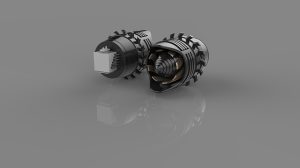
O-rings are an important part of jet engines. Also known as toric joints, they are elastomeric mechanical seals in the shape of a ring. Like with other seals, O-rings prevent leaks from occurring. They will compress the mating surface of a fluid- or gas-filled passage so that it doesn’t leak.
Automobiles, for instance, often use O-rings around coolant hoses. Coolant hoses will connect to the radiator, heater core and engine. At these mating surfaces, O-rings are used to prevent leaks from occurring. In addition to automobiles, though, O-rings are commonly used in jet engines. How do jet engines use O-rings exactly?
Prevents Jet Fuel From Leaking
The fuel lines used in jet engines are typically fitted with O-rings. Jet engines run on jet fuel. Jet fuel must travel from the airplane’s fuel tank to its jet engines. Upon reaching the airplane’s jet engines, the jet fuel will mix with air before igniting. This ignition will create the combustion necessary to propel the airplane through the skies.
You’ll often find O-rings around the jet fuel lines. Jet fuel lines are pressurized. They rely on pressure to move the jet fuel from the airplane’s fuel tank to its jet engines. Because they are pressurized, mating surfaces must be equipped with some type of pressure-resistant seal. O-rings can withstand this pressure while subsequently keeping the jet fuel within the lines and preventing it from leaking.
Characteristics of Jet Engine O-Rings
All O-rings are elastomeric mechanical seals in the shape of a ring. With that said, O-rings designed for use with jet engines typically feature some unique characteristics.
Jet engine O-rings can withstand jet fuel. While jet fuel may degrade other types of O-rings, this isn’t a concern for jet engine O-rings. They are made of special materials, such as fluorocarbon or fluorosilicone rubber, that are able to withstand the harsh properties of jet fuel.
Jet engine O-rings are also heat resistant. They won’t melt, crack or otherwise sustain damage when exposed to heat. Most O-rings will, in fact, expand when exposed to heat. This expansion, however, helps to create a tighter seal. And after an O-ring has cooled off, it will return to its original size. Regardless, jet engine O-rings are heat resistant.
In Conclusion
Jet engines use O-rings to seal the mating surfaces of their fuel lines. Fuel lines carry jet fuel from the airplane’s fuel tank to its jet engines. To prevent leaks from occurring, O-rings are used around the mating surfaces of these fuel lines.



